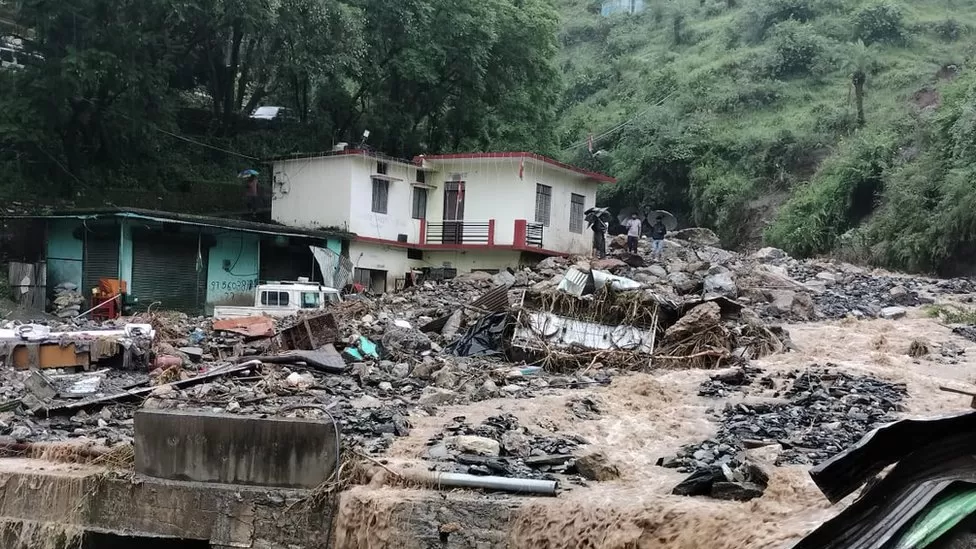More rain, less snow are turning Himalayas dangerous

The terrain is becoming even more dangerous due to an unusual increase in rainfall.
This month, landslides and flash floods have already killed dozens in the area, burying homes and buildings. Pakistan and Nepal have also been affected.
In recent years, mountains across the globe, including the Himalayas, have seen more rainfall at elevations where they have mostly snowed.
Increasing temperatures have made the mountains more dangerous, as they not only bring rain but also accelerate the melting of snow and ice. Rainwater also loosens soil, causing landslides, rockfalls, floods, and debris flows.
The study, published in Nature in June, provides several lines of evidence that warming is amplifying rainfall extremes at high altitudes, especially in snow-dominated regions of the Northern Hemisphere.
According to a special report by the Intergovernmental Panel on Climate Change (IPCC) in 2019, snowfall had decreased, at least partly due to higher temperatures, especially at lower elevations.
Samuel Morin, executive director of the National Centre for Meteorological Research in France and one of the authors of the IPCC report, says extreme precipitation events have increased in recent years, even at high altitudes and during all seasons.
Global warming has caused the zero-degree isotherm, the freezing level at which precipitation falls as snow, to move higher.
According to the study, these [mountain] regions are considered hotspots due to their high risk of extreme rainfall events, flooding, landslides, and soil erosion. This risk is higher for the Himalayan region compared to other mountainous regions like the Alps and the Rockies in the northern hemisphere, Mohamed Ombadi, the study’s lead author told the BBC.
Additional warming-related processes [in the Himalayas] change wind patterns and storm tracks, increasing storm intensity.”
Almost no weather stations are found in the Himalayas, which span India, Bhutan, Nepal, and Pakistan.
Few stations are located in the lower elevations of the mountains, but they do not indicate whether precipitation is rain or snow.
According to a weather station installed at Mount Everest’s base camp, 75% of the 245.5mm of precipitation that fell on the mountain between 1 June and 10 August this year fell as rain. The rest was snow or a combination of snow and rain.
There was 32% of rain between June and September in 2022, 43% in 2021, and 41% in 2020.
“We believe the dominance of rain vs snow is a relatively recent phenomenon but we don’t have longer-term data to fully quantify that,” Baker Perry and Tom Matthews, who installed the station with National Geographic and Rolex Perpetual Planet Expeditions, said.
The terrain is becoming even more dangerous due to an unusual increase in rainfall.
This month, landslides and flash floods have already killed dozens in the area, burying homes and buildings. Pakistan and Nepal have also been affected.
In recent years, mountains across the globe, including the Himalayas, have seen more rainfall at elevations where they have mostly snowed.
Increasing temperatures have made the mountains more dangerous, as they not only bring rain but also accelerate the melting of snow and ice. Rainwater also loosens soil, causing landslides, rockfalls, floods, and debris flows.
The study, published in Nature in June, provides several lines of evidence that warming is amplifying rainfall extremes at high altitudes, especially in snow-dominated regions of the Northern Hemisphere.
According to a special report by the Intergovernmental Panel on Climate Change (IPCC) in 2019, snowfall had decreased, at least partly due to higher temperatures, especially at lower elevations.
Samuel Morin, executive director of the National Centre for Meteorological Research in France and one of the authors of the IPCC report, says extreme precipitation events have increased in recent years, even at high altitudes and during all seasons.
Global warming has caused the zero-degree isotherm, the freezing level at which precipitation falls as snow, to move higher.
According to the study, these [mountain] regions are considered hotspots due to their high risk of extreme rainfall events, flooding, landslides, and soil erosion. This risk is higher for the Himalayan region compared to other mountainous regions like the Alps and the Rockies in the northern hemisphere, Mohamed Ombadi, the study’s lead author told the BBC.
Additional warming-related processes [in the Himalayas] change wind patterns and storm tracks, increasing storm intensity.”
Almost no weather stations are found in the Himalayas, which span India, Bhutan, Nepal, and Pakistan.
Few stations are located in the lower elevations of the mountains, but they do not indicate whether precipitation is rain or snow.
According to a weather station installed at Mount Everest’s base camp, 75% of the 245.5mm of precipitation that fell on the mountain between 1 June and 10 August this year fell as rain. The rest was snow or a combination of snow and rain.
There was 32% of rain between June and September in 2022, 43% in 2021, and 41% in 2020.
“We believe the dominance of rain vs snow is a relatively recent phenomenon but we don’t have longer-term data to fully quantify that,” Baker Perry and Tom Matthews, who installed the station with National Geographic and Rolex Perpetual Planet Expeditions, said.
